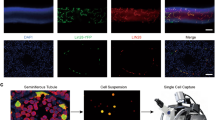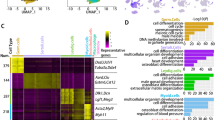Abstract
Laser microdissection (LMD) is a selective cell isolation technique that enables the separation of desired homogenous cell subpopulations from complex tissues such as the testes under direct microscopic visualization. The LMD accompanied by quantitative reverse transcriptase polymerase chain reaction (qRT-PCR) represents an indispensable tool in quantifying messenger RNA (mRNA) expression among defined cell populations. Gene expression is temporally and spatially regulated at 3 sequential phases of mitotic, meiotic, and postmeiotic stages of spermatogenesis. The present study demonstrates a short modified LMD protocol based upon hematoxylin and eosin (H&E) staining. Stage-specific LMD success was validated by the use of mRNA profiling of “marker genes” which are conserved across species and are known to be differentially expressed during spermatogenesis. Magea4, Hspa2, Cox6b2, Tnp1, Prm1, and Prm2 are used to differentiate among the microdissected cell populations, namely spermatogonia (group I), spermatocytes (group II), round and condensing spermatids (group III), and elongated and condensed spermatids (group IV), respectively. The LMD combined with qRT-PCR is further extended to assess the cell stage-specific distribution of selected stress response genes such as Hsp90aa1, Gpx4, Ucp2, Sod1, and Sod2. The germ cell-specific mRNA profiles are suitably complemented by Western blot of the LMD samples, immunohistochemistry, and confocal localization of the corresponding proteins. The current study suggests that LMD can successfully isolate cell subpopulations from the complex tissues of the testes; and establish cell stage-specific basal expression patterns of selected stress response genes and proteins. It is our hypothesis that the baseline expression of stress response genes will differ by cell stage to create discrete stage-specific vulnerabilities to reproductive toxicants.
Similar content being viewed by others
References
Kerr JB. Macro, micro, and molecular research on spermatogenesis: the quest to understand its control. Micro Res Tech. 1995;32: 364–384.
Bonner RF, Emmert-Buck M, Cole K, et al. Laser capture microdissection: molecular analysis of tissue. Science. 1997;278(5342): 1481–1483.
Fend F, Raffeld M. Laser capture microdissection in pathology. J Clin Pathol. 2000;53(9):666–672.
Kohda Y, Murakami H, Moe OW, Star RA. Analysis of segmental renal gene expression by laser capture microdissection. Kidney Int. 2000;57(1):321–331.
Luo L, Salunga RC, Guo H, et al. Gene expression profiles of laser-captured adjacent neuronal subtypes. Nat Med. 1999;5(1): 117–122.
Sgroi DC, Teng S, Robinson G, LeVangie R, Hudson JR Jr, Elkahloun AG. In vivo gene expression profile analysis of human breast cancer progression. Cancer Res. 1999;59(22): 5656–5661.
Sluka P, O’Donnell L, Stanton PG. Stage-specific expression of genes associated with rat spermatogenesis: characterization by laser-capture microdissection and real time polymerase chain reaction. Biol Reprod. 2002;67(3):820–828.
Sluka P, O’Donnell L, MacLachlan RI, Stanton PG. Application of laser-capture microdissection to analysis of gene expression in the testis. Prog Histochem Cytochem. 2008;42(4):173–201.
Espina V, Milia J, Wu G, Cowherd S, Liotta LA. Laser capture microdissection. Methods Mol Biol. 2006;319:213–229.
Leblond CP, Clermont Y. Spermiogenesis of rat, mouse, hamster and guinea pig as revealed by the periodic acid-fuchsin sulfurous acid technique. Am J Anat. 1952;90(2):167–215.
Russell LD, Ettlin RA, SinhaHikim APS, et al. Histological and Histopathological Evaluation of the Testis. Clearwater, FL: Cache River Press; 1990.
Hess R, de Franca L. Spermatogenesis and cycle of the seminiferous epithelium. In: Cheng CY, ed. Molecular Mechanisms in Spermatogenesis. Austin, TX: Landes Bioscience/Springer Science; 2008;1–15.
Eddy EM. Male germ cell gene expression. Recent Prog Horm Res. 2002;57:103–128.
Hemendinger RA, Gores P, Blacksten L, Harley V, Halberstadt C. Identification of a specific Sertoli cell marker, Sox9, for use in transplantation. Cell Transplant. 2002;11(6):499–505.
Teerds KJ, de Boer-Brouwer M, Dorrington JH, Balvers M, Ivell R. Identification of markers for precursor and leydig cell differentiation in the adult rat testis following ethane dimethyl sulphonate administration. Biol Reprod. 1999;60(6):1437–1445.
Kokk K, Veräjänkorva E, Laato M, Wu XK, Tapfer H, Pöllänen P. Expression of insulin receptor substrates 1–3, glucose transporters GLUT-1-4, signal regulatory protein 1α, phosphatidylinositol 3-kinase and protein kinase B at the protein level in the human testis. Anat Sci Int. 2005;80(2):91–96.
Bustin SA, Benes V, Garson JA, et al. The MIQE Guidelines: minimum information for publication of quantitative real-time PCR experiments. Clin Chem. 2009;55(4):611–622.
Braun Robert E. The Mammalian Reproductive Genetics Database. Bar Harbor, ME: The Jackson Laboratory; 2010. http://mrg.gs.washington.edu. Accessed August 31, 2010.
Shima JE, McLean DJ, McCarrey JR, Griswold MD. The murine testicular transcriptome: characterizing gene expression in the testis during the progression of spermatogenesis. Biol Reprod. 2004;71(1):319–330.
Guo R, Yu Z, Guan J, et al. Stage-specific and tissue-specific expression characteristics of differentially expressed genes during mouse spermatogenesis. Mol Reprod Dev. 2004;67:264–272.
Erickson HS, Albert PS, Gillespie JW, et al. Quantitative RT-PCR gene expression analysis of laser microdissected tissue samples. Nat Protoc. 2009;4(6):902–922.
Vinas J, Piferrer F. Stage-specific gene expression during fish spermatogenesis as determined by laser-capture microdissection and quantitative-PCR in sea bass (Dicentrarchus labrax) gonads. Biol Reprod. 2008;79(4):738–747.
Suarez-Quian CA, Goldstein SR, Bonner RF. Laser capture microdissection: a new tool for the study of spermatogenesis. J Androl. 2000;21(5):601–608.
Weber JE, Russell LD, Wong V, Peterson RN. Three dimensional reconstruction of a rat stage V Sertoli cell. II. Morphometry of Sertoli-Sertoli and Sertoli-germ cell relationships. Am J Anat. 1983;167(2):163–179.
Guten IV, Torres B, Bols PRJ. Flow cytometry purification of mouse meiotic cells. J Vis Exp. 2011;50:e2602. doi:10.3891/2602(2011).
Namekawa SH, Park PJ, Zhang LF, et al. Post meiotic sex chromatin in the male germ line of mice. Current Biol. 2006;16:660–667.
Takahashi K, Shichijo S, Noguchi M, Hirohata M, Itoh K. Identification of MAGE-1 and MAGE-4 proteins in spermatogonia and primary spermatocytes of testis. Cancer Res. 1995;55(16): 3478–3482.
Chambost H, Van Baren N, Brasseur F, et al. Expression of gene MAGE-A4 in Reed-Sternberg cells. Blood. 2000;95(11): 3530–3533.
Allen JW, Dix DJ, Collins BW, et al. HSP70-2 is part of the synaptonemal complex in mouse and hamster spermatocytes. Chromosoma. 1996;104(6):414–421.
Zakeri ZF, Wolgemuth DJ, Hunt CR. Identification and sequence analysis of a new member of the mouse HSP70 gene family and characterization of its unique cellular and developmental pattern of expression in the male germ line. Mol Cell Biol. 1988;8: 2925–2932.
Son W, Hwang S, Han C, Lee JH, Kim S, Kim YC. Specific expression of heat shock protein HspA2 in human male germ cells. Mol Hum Reprod. 1999;5(12):1122–1126.
Sasaki T, Marcon E, McQuire T, et al. Bat3 deficiency accelerates the degradation of Hsp70-2/HspA2 during spermatogenesis. J Cell Biol. 2008;182:449–458.
Hüttemann M, Kadenbach B, Grossman LI. Mammalian subunit IV isoforms of cytochrome c oxidase. Gene. 2001;267(1): 111–123.
Mali P, Kaipia A, Kangasniemi M, et al. Stage-specific expression of nucleoprotein mRNAs during rat and mouse spermiogenesis. Reprod Fertil Dev. 1989;1(4):369–382.
Brewer L, Corzett M, Balhorn R. Condensation of DNA by spermatid basic nuclear proteins. J Biol Chem. 2002;277:3885–3890.
Zhao M, Shirley CR, Hayashi S, et al. Transition nuclear proteins are required for normal chromatin condensation and functional sperm development. Genesis. 2004;38:200–213.
Sutovsky P, Manandhar G. Mammalian spermatogenesis and sperm structure: anatomical and compartmental analysis. In: De jonge C, Barrett C, eds. The Sperm Cell: Production, Maturation, Fertilization, Regeneration. Cambridge, UK: The Cambridge Press; 2006:1–30.
Aitken RJ, Baker MA. Oxidative stress, sperm survival and fertility control. Mol Cell Endocrinol. 2006;250(1–2):66–69.
Aguilar-Mahecha A, Hales BF, Robaire B. Expression of stress response genes in germ cells during spermatogenesis. Biol Reprod. 2001;65(1):119–127.
Hales DB, Allen JA, Shankara T, et al. Mitochondrial function in Leydig cell steroidogenesis. Ann N Y Acad Sci. 2005;1061: 120–134.
Aitken RJ, Roman SD. Antioxidant systems and oxidative stress in the testes. Adv Exp Med Biol. 2008;636:154–171.
Grad I, Cederroth CR, Walicki J, et al. The molecular chaperone HSP90A is required for meiotic progression of spermatocytes beyond pachytene in the mouse. PLoS One. 2010;5:1–11.
Yufu Y, Nishimura J, Nawata H. High constitutive expression of heat shock protein 90α in human acute leukemia cells. Leuk Res. 1992;16(6–7):597–605.
Biggiogera M, Fakan S, Leser G, Martin TE, Gordon J. Immunoelectron microscopic visualization of ribonucleoproteins in the chromatoid body of mouse spermatids. Mol Reprod Dev. 1990; 26(2):150–158.
Simmons SO, Fan CY Ramabhadran. Cellular stress pathway systems as a sentinel in toxicological screening. Toxicol Sci. 2009; 111(2):202–225.
Pushpa-Rekha TR, Burdsall AL, Oleksa LM, Chisolm GM, Driscoll DM. Rat phospholipid-hydroperoxide glutathione peroxidase. cDNA cloning and identification of multiple transcription and translation start sites. J Biol Chem. 1995;270(45): 26993–26999.
Nam SY, Fujisawa M, Kim JS, Kurohmaru M, Hayashi Y. Expression pattern of phospholipid hydroperoxide glutathione peroxidase messenger ribonucleic acid in mouse testis. Biol Reprod. 1998;58(5):1272–1276.
Puglisi R, Bevilacqua A, Carlomagno G, et al. Mice over expressing the mitochondrial phospholipid hydroperoxide glutathione peroxidase in male germ cells show abnormal spermatogenesis and reduced fertility. Endocrinology. 2007;148:4302–4309.
Imai H, Hakkaku N, Iwamoto N, et al.. Depletion of selenoprotein GPx4 in spermatocytes causes male infertility in mice. J Biol Chem. 2009;284:32522–32532.
Flachs P, Sponarova J, Kopecky P, et al. Mitochondrial uncoupling protein 2 gene transcript levels are elevated in maturating erythroid cells. FEBS Lett. 2007;581(6):1093–1097.
Mattiasson G, Sullivan PG. The emerging functions of ucp2 in health, disease, and therapeutics. Antioxid Redox Signal. 2006; 8(1–2):1–38.
Fleury C, Neverova M, Collins S, et al. Uncoupling protein-2: a novel gene linked to obesity and hyperinsulinaemia. Nat Genet. 1997;15(3):269–272.
Zhang, Shang Y, Liao S, et al.. Uncoupling protein 2 protects testicular germ cells from hyperthermia-induced apoptosis. Biochem Biophys Res Commun. 2007;360(2):327–332.
Lasso JL, Noiles EE, Alvarez JG, et al. Mechanism of superoxide dismutase loss from human sperm cells during cryopreservation. J Androl. 1994;15:255–265.
Gu W, Morales C, Hecht NB. In male mouse germ cells, copperzinc superoxide dismutase utilizes alternative promoters that produce multiple transcripts with different translation potential. J Biol Chem. 1995;270(1):236–243.
Gu W, Hecht NB. Developmental expression of glutathione peroxidase, catalase, and manganese superoxide dismutase mRNAs during spermatogenesis in the mouse. J Androl. 1996;17(3):256–262.
Author information
Authors and Affiliations
Corresponding author
Rights and permissions
About this article
Cite this article
Esakky, P., Hansen, D.A., Drury, A.M. et al. Molecular Analysis of Cell Type-Specific Gene Expression Profile During Mouse Spermatogenesis by Laser Microdissection and qRT-PCR. Reprod. Sci. 20, 238–252 (2013). https://doi.org/10.1177/1933719112452939
Published:
Issue Date:
DOI: https://doi.org/10.1177/1933719112452939




